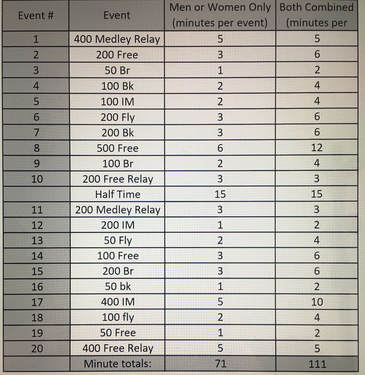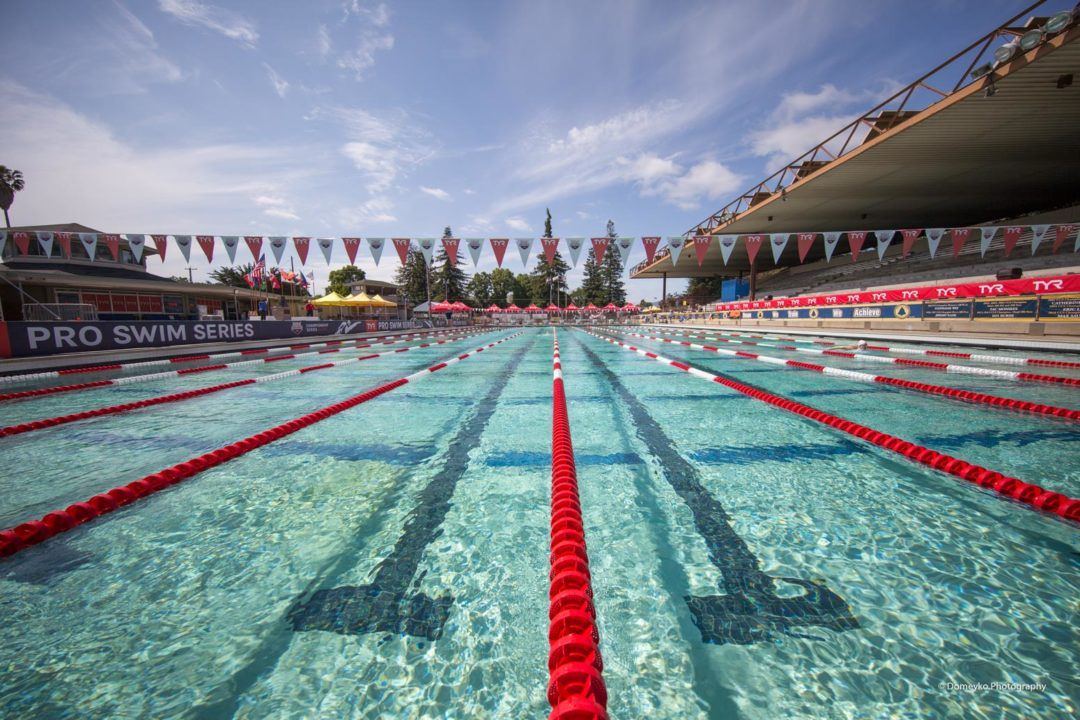SwimSwam welcomes reader submissions about all topics aquatic, and if it’s well-written and well-thought, we might just post it under our “Shouts from the Stands” series. We don’t necessarily endorse the content of the Shouts from the Stands posts, and the opinions remain those of their authors. If you have thoughts to share, please send [email protected].
This “Shouts from the Stands” submission comes from Shawn King.
In Part I, 6 major issues where presented that limit professional swimming: relevancy in national and world athletics, meet organization and duration, meet scoring procedures, team construct and organization, meaningful statistics that increase athlete value, and an annual defined high performance season. Each of these items was discussed in detail how it influences and limits the growth of professional swimming.
Here in Part II, the outline for a professional swimming league is presented, answering the 6 major issues discussed in part I.
Swimming as a sport is on the cusp of defining its long term future. For the first time in decades, USA Swimming didn’t experience the rise in membership it usually does following an Olympic year. For the first Olympics since 2000, Michael Phelps will not be there helping to fuel a swimming dominant story. Collegiate programs continue to die because there is not consistent interest in the sport by fans.
The situation is dire. Swimming as a sport can evolve. By observing other successful professional sports and patterning a swimming league after them, swimming can rise as viable and successful professional sport. As professional sport expands, collegiate swimming will have a model they can follow to resolve the same limiting issues within their sport.
Here in Part II, the outline for a professional swimming league is presented, answering the 6 major issues discussed in part I.
A professional swimming league: The National Swimming League
SECTION 1. Increase Relevancy
The National Swimming League (NSL) is an association of Swimming teams following the same format as the National Football League. The NSL provides a league format wherein teams compete in duel meets to qualify for the playoffs, and through single elimination meets, win the NSL Championship. Teams are made up of professional swimmers under contracts with their teams. Competitive rosters consist of 24 athletes (12 women, 12 men). Following the lead of the NFL and MLS, swimming would have a limited number of duels with the focus being on racing to win. Teams battle to eliminate one another and advance to the championship. With a limited number of meets/games, each race becomes very exciting and valuable in the landscape of the teams progress throughout the season.
SECTION 2. Team
This inclusion of men and women in the same professional level meet is unique in professional sports and provides an excellent opportunity for growth and expansion as an all-inclusive sport. This idea cannot be understated. The amount of media attention that could be delivered to the sport that brings men and women together with equal opportunity to compete and provide them the opportunity to compete together for championships and receive equal press and pay, would be revolutionary in the world of sports. This one idea has within it the power to forever change the landscape of professional sports.
To build on the combining of men and women into the same professional league, transitioning from the individual format to the team format allows teams to create deeper fan bases than an individual athlete can collect on their own. Stars can collect together to pursue championships won in duel meets, where the emphasis is on racing and scoring, not times and gold medals. Athletes would have a specific time of year where their performances were critical and fans could flock to the sport for the given season.
SECTION 3. Define Season
The NSL season would begin in mid-April, after the PGA Masters and before the beginning of the NBA playoffs and NFL Draft. Teams play weekly on Friday or Saturday for 13 weeks. Each team has 12 meets with a single bye week. The top 8 teams with the best duel meet records would be entered in the playoffs. Single elimination duels would play to eliminate teams from 8 to 4 to 2, with the final NSL duel acting as the season championship. The regular season and playoffs would place the championship meet about the 2nd week of August. This summer season is critical to allow the NSL to maximize its relevance during a down time in the US Sports Cycle. The 8 weeks following the conclusion of the NBA and NHL seasons is open and dead space until the start of the NFL season at the end of August. All sports media agencies are searching for content during this time of the year. Swimming could easily fill the space. The crucial meets qualifying for the playoffs take place just as the NBA and NHL finals finish, allowing casual fans to join the league in time for the drama of making the playoffs and the start of the elimination rounds. With only 3 weeks of elimination meets, the NSL Championship will be determined in the middle of August. To conclude the season, the NSL draft would take place at the end of August or early September and would mark the official end of the NSL season. The season would then finish before the start of football season.
Section 4. Improve Events
Based loosely on the current college duel meet event program, the NSL league meets would have 16 individual events for both women and men (32) and 4 mixed relays event meet schedule with 20 events. A 15 minute half-time will be scheduled halfway through the meet.

This particular event schedule allows a single duel (either men or women) to be completed within an hour and a half, while a full duel (both men and women together) can be completed within 2 hours. This is much more standard in the event length in comparison to the other major professional sports. In single duel format, each event has a single heat with 3 athletes for individuals or 2 relays from each team entered for competition. In the full duel format, there will remain a single heat for combined relays (2 women/2 men) and then proceed with 2 heats for each event (1 women’s heat and 1 men’s heat).
This inclusion of men and women in the same professional level meet/game is unique in professional sports and provides an excellent opportunity for growth and expansion as an all-inclusive sport.
The abbreviated times for competitions makes the events much more media and fan friendly, with opportunities for the athletes to truly showcase their ability within the given time frame. With no limitations on events, star athletes can get more pool time and both fans and media are able to maximize their value in watching the stars. This event format also frames the athletes’ performances within a relevant scenario with a win/loss result from the meet, giving value to the overall performance.
Due to the focus on winning and losing, and not breaking time records, the league could bring back the polyurethane body suits of old. These suits would improve the speed of the meet and also bring a unique look that would allow men and women to have a similar while supporting large team logos and sponsors. These suits could add flair and fun to the event while allowing athletes to perform at the highest levels.
SECTION 5. Simplify Scoring
Athletes will not be limited in the number of events they can swim, allowing teams greater flexibility to maneuver and score points with the athletes available. Each event is scored according to a six (6) place scoring: 6, 4, 3, 2, 1, 0. Relays are four (4) place scoring: 12, 8, 4, 0
This scoring system, while based upon the NCAA design, is different due to the need to have closer scoring. The NCAA system places a much higher value on 1st place finishes, which plays to top-heavy teams. While this is important, lowering the value of the top score makes depth within the teams more valuable and will keep the scores closer, creating more compelling matchups from week to week. This scoring is also much more simple than the 16 or 20 place scoring implemented in most of the high level championship meets held, and can be calculated quickly by most anyone watching the meet.
SECTION 6. Track Statistics
With no entry limit, points per game becomes a viable statistic that can help to contribute to building records and defining player value beyond specific record times. While times will always be a part of swimming, allowing players to collect statistics such as points per game, relays swum, the number of 1st, 2nd, 3rd place finishes, etc. allows athletes to compete without the need to have a World Record time with every swim. The development of new ways to value swimming athletes can help to increase the longevity of the careers of swimming pro athletes, while engaging audiences and fans with their favorite players. Multiple ways of measuring value and impact improves the diversity of the sport.
Conclusion
Swimming is a beautiful sport. In its simplicity, it is compelling and captivating to watch humans move gracefully through the water at speeds we can barely understand. By learning from other successful professional sports, swimming can be molded into a thrilling professional sport that can gather followers from around the world. The professional league format can be adapted to high school and college swimming, as well as formed into a World Cup format similar to the current soccer and basketball World Cups.
If we are willing to step outside the parameters of what swimming has been and look forward to what swimming could truly be, we find that we could build a fast, compelling sport that would be exciting and enjoyable for athletes, coaches, officials, and fans.
About Shawn King
 Shawn King is the National Development Coach for the Southern Utah Swimming Association in St. George, UT. Previously, Shawn worked as the Membership Director at the American Swimming Coaches Association. Shawn has been committed to bringing elite swimming to southern Utah and has seen a Utah High School State Title and SUSA’s first Jr. National qualifier this last season. Shawn is married and has 4 boys.
Shawn King is the National Development Coach for the Southern Utah Swimming Association in St. George, UT. Previously, Shawn worked as the Membership Director at the American Swimming Coaches Association. Shawn has been committed to bringing elite swimming to southern Utah and has seen a Utah High School State Title and SUSA’s first Jr. National qualifier this last season. Shawn is married and has 4 boys.

it must have the cheerleaders’ performance in the half time.
yards is not the format to sell the sport
Ya sure? Short course is definitely more exciting and all the pros still have the pro series for long course. Could be fun for them, most train in SCY a lot of the time
I could be wrong, but I believe Bo Swims was meaning make it SCM, especially if you’re wanting international attention. I think a long course format would be too grueling for a long season where mid-season meets would have more importance than they currently do. That being said, if this were being run primarily in the US, SCY is going to be much more convenient given how many pools are already built that way.
What about having the meet include some of the top junior swimmers to showcase the “up and coming” stars of the sport? In between events for the pros, you have the Juniors do their event. You wouldn’t need to show the event live, so you could just show the highlights of the Junior events on TV. This would also give fans a reason to show up since they’d be watching their kids and teammates in addition to watching world Class swimmers. Not many sports would be able to do such a thing.
Also, with one of the greatest stars in the sport being a distance swimmer (Ledecky), you NEED to include the mile, or at least the 800. With a… Read more »
You’re now at 4 hours . . . . or more.
The only positive to that would be increased audience for those younger swimmers family and friends. lengthens the meet a ton though, not worth it.
Great ideas!
But PLEASE: It’s “dual”, not “duel”. It’s a “Dual Meet” because it’s a meet between two teams, like a duet is a song with two singers.
OH! Missed it by THAT much. Started strong, but fizzled . . . .
This needs to happen, the bit about the full body suits coming back would be great for team designs and sponsors. I think it would definitely have to be done in long course if you wanted olympians to take it seriously.
Pro athletes need sponsors and for that you need “clothes.” Full body suits aren’t going to be a realistic option though if we want WRs to mean anything.
I think it would be more exciting to do short course honestly. Olympians all swam SCY at some point and were good at it. Maybe switch it up and do half and half. “playoffs” could be winter nationals
and no definitely not full body suits
Similar must be done at the US Age Group level. We lose talented swimmers (and parents) who opt out of 6hour meets for 1hour basketball, soccer and baseball games with much more visceral feedback.. And these are our swimmers with the most athleticism!
Swimming competitions must become more compelling.
There’s are solutions.
No Distance events? Hmmm… sound like sprinting is the future of USA swimming… No thank you!
TBH unless you’re watching KL lap people and be past the WR line on TV, very few people enjoy watching the Mile. If swimming pools weren’t so damn expensive, you could have the distance events running in a separate pool at the same time like Track and Field does, but unfortunately that’ll never work.
Sprinting is what people want to watch. The market decides
Great ideas, especially about the condensed time for a meet to take place. As a parent who spent thousands of hours on deck waiting and watching for the 3 or 4 events in which my son swam, I like the idea that this format would allow you to view the entire competition in a couple of hours. Considering how much actual “playing” you see in an NFL game verses how long the program takes (huddles, timeouts, measurements, penaltie, etc. etc. etc.), this swimming format appears to have almost non-stop action for the viewer. Even in the Olympics, there is so much time spent on “between the actual swimming” stuff that it is easy for the viewer to lose attention and… Read more »